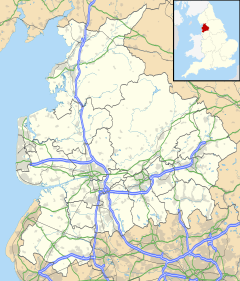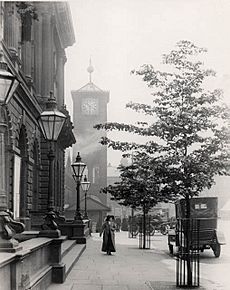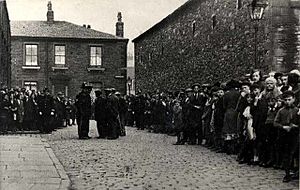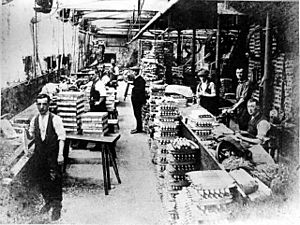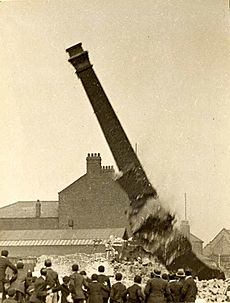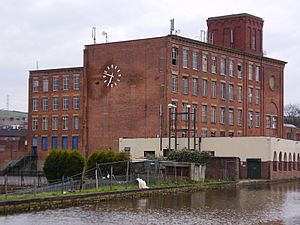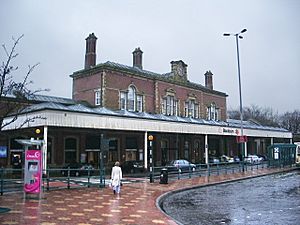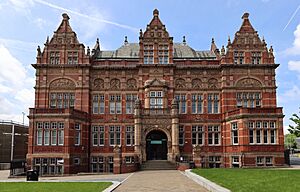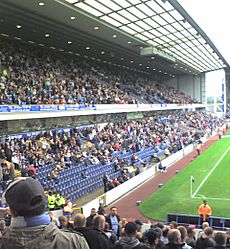Blackburn facts for kids
Quick facts for kids Blackburn |
|
|---|---|
| Town | |
|
|
| Population | 120,500 |
| • Density | 11,114/sq mi (4,291/km2) |
| Demonym | Blackburnian |
| OS grid reference | SD685277 |
| • London | 184 mi (296 km) SSE |
| Unitary authority | |
| Ceremonial county | |
| Region | |
| Country | England |
| Sovereign state | United Kingdom |
| Post town | BLACKBURN |
| Postcode district | BB1, BB2 |
| Dialling code | 01254 |
| Police | Lancashire |
| Fire | Lancashire |
| Ambulance | North West |
| EU Parliament | North West England |
| UK Parliament |
|
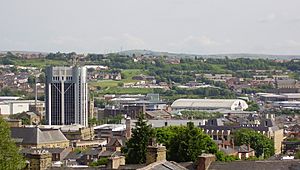
Blackburn is a busy town in Lancashire, England. It's the main center of the Blackburn with Darwen area. The town is located north of the West Pennine Moors and on the southern edge of the Ribble Valley. It's about 8 mi (13 km) east of Preston and 21 mi (34 km) north-northwest of Manchester. Blackburn is the second largest town in Lancashire, after Blackpool.
In 2011, Blackburn had a population of about 118,000 people. The wider area of Blackburn with Darwen had about 150,000 people. Blackburn has a diverse population, with many different ethnic backgrounds.
Blackburn used to be famous for making textiles, especially cotton. This industry started way back in the 1200s. People would weave wool in their homes. Later, in the 1300s, weavers from a place called Flanders came and helped the wool industry grow. The town grew very fast during the Industrial Revolution, when factories started making huge amounts of textiles.
After the mid-1900s, the textile industry in Blackburn began to slow down. Like many towns in Northern England, Blackburn faced new challenges. But the town has received a lot of money and help since 1958 to rebuild and improve.
Contents
- Blackburn's Past: A Journey Through Time
- How Blackburn is Governed
- Blackburn's Location and Climate
- Blackburn's People
- Blackburn's Economy
- Getting Around Blackburn
- Famous Places in Blackburn
- Learning in Blackburn
- Local News and Entertainment
- Sports in Blackburn
- Famous Faces from Blackburn
- Blackburn's Twin Towns
- See also
Blackburn's Past: A Journey Through Time
What's in a Name?
Blackburn was first written down as Blacheborne in a very old book called the Domesday Book in 1086. We're not totally sure where the name comes from. Some people think it means a "bleaching stream," because of a process used to make cloth white. Others believe it simply means "black stream."
Ancient Times
There isn't much proof of people living in the Blakewater valley, where Blackburn grew, a very long time ago. However, some ancient burial urns from the Bronze Age have been found in the hills around the town. In 1879, an urn was found at Revidge, and another in 1996 at Pleasington Cemetery. There's also a special spring called All Hallows Spring in the town center. It might have been used as a sacred place during the Iron Age.
Roman Connections
Blackburn is located where a Roman military road crossed the River Blakewater. This road connected two important Roman forts: Bremetennacum (Ribchester) and Mamucium (which is now Castlefield in Manchester). The road likely went east of Blackburn Cathedral and crossed the river near the Salford area. It's unclear if the road was there before people settled in the area.
- Roman Temple Spring
In 1654, people dug up All Hallows Spring and found a stone. This stone showed that a temple was built there for a god named Serapis by a Roman leader named Claudius Hieronymus.
The Middle Ages
People believe Christianity came to Blackburn around the late 500s. There's a record of a "church of Blagbourne" from that time. Blackburn was important during the Anglo-Saxon period. The area became known as the Blackburnshire Hundred, a way of dividing up the land in the kingdom of Northumbria.
The town's name, Blachebourne, appears in the Domesday Book. It was a royal manor during the time of King Edward the Confessor and William the Conqueror. When the old parish church (now the cathedral) was taken down in 1820, evidence showed a church was built there in the late 1000s or early 1100s. A market cross was also put up nearby in 1101. Blackburn's importance lessened in the 1100s as Clitheroe became a bigger regional center.
The Rise of Textiles and the Industrial Revolution
Textile making in Blackburn began in the mid-1200s. Farmers would weave wool from their own farms at home. Flemish weavers, who came in the 1300s, helped this industry grow. By 1650, Blackburn was known for its "Blackburn checks" and "Blackburn greys" fabrics. By the early 1700s, textile making was Blackburn's main business. From the mid-1700s to the early 1900s, Blackburn grew from a small market town to "the weaving capital of the world." Its population jumped from under 5,000 to over 130,000!
Around 1750, cotton textile making grew very fast. People working from their homes would spin cotton into thread and weave it into cloth. Merchants would then arrange for the cloth to be bleached and dyed.
After 1775, cotton spinning mills were built in the town. The first mill built just for spinning opened in 1797. By 1824, there were 24 such mills. The number of spindles (parts of machines that spin thread) reached 2.5 million by 1870. However, spinning started to decline in Blackburn between 1870 and 1900, moving to other parts of Lancashire.
In the 1700s, most weaving in Blackburn was done by handloom weavers in their homes. But after 1825, power looms were brought into factories. This meant fewer people were needed for hand weaving. The last handloom shop in Blackburn closed in 1894.
Better power looms in the 1840s and a new railway line in 1846 brought more investment to Blackburn. The railway helped the cotton trade grow. Many new mills were built in the following decades. Between 1850 and 1870, 68 mills just for weaving and four combined weaving/spinning mills were constructed.
- The Power-Loom Riots
The new power looms were very efficient. This meant that weaving, which was how many people earned a living, moved from homes to factories. This caused a lot of people to lose their jobs. In March 1826, about 60% of handloom weavers in Blackburn and nearby areas were unemployed. This led to the Lancashire weavers' riots. On April 24, 1826, a large group of people came to Blackburn. They destroyed 212 power looms at one factory and 25 more at another. Soldiers arrived to stop the rioting.
The Cotton Industry Slows Down
In 1890, leaders in Blackburn realized the town relied too much on cotton. They warned about having "only one string to their bow." This warning came true. In 1904, the cotton industry faced a slump. Other businesses that depended on cotton, like engineering and building, also suffered. In 1908, another slump meant 43 mills stopped making things, and a quarter of the town's looms were not being used.
During World War I, trade with India was stopped. This helped India's cotton industry grow, but it hurt Britain's. In 1921, trade dropped a lot. This got even worse in 1922 when India added a tax on imported goods. This caused 47 mills to stop production, leaving 43,000 looms idle. Some mills closed forever. In 1926, the General Strike stopped production at half the town's mills, and 12,000 people lost their jobs. By 1930, 50 mills had closed, and 21,000 people were unemployed.
After World War II, there was a short boom in the cotton industry from 1948 to 1950. Sales went up, and new automatic looms were introduced. These looms allowed one weaver to control many machines. But even with this, the cotton industry kept declining. By 1951, only 25% of the town's people worked in textiles, down from 60% before the Great Depression. By 1955, more cloth was being imported from India than exported. Between 1955 and 1958, 16 more mills closed. By 1960, 30 mills were still working in Blackburn.
Closures continued through the 1960s and 1970s. By 1975, only 6,000 people worked in textiles in Blackburn. In 1976, there were only 2,100 looms working in the town, compared to almost 80,000 in 1907.
Brewing History
In 1807, the Daniel Thwaites & Co brewery started. This company still makes beer today! Another brewery, Matthew Brown & Co., moved to Blackburn in 1927. It stopped brewing in 1991.
How Blackburn is Governed
Blackburn is managed by the Blackburn with Darwen local council. This council looks after Blackburn and the nearby town of Darwen. The town also sends one person, called a MP, to the House of Commons in London.
Blackburn's Coat of Arms
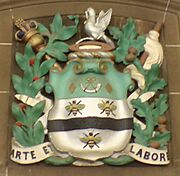
The coat of arms for Blackburn has many special symbols. Its Latin motto is Arte et Labore, which means 'By art and by labour' or 'By skill and hard work'. This motto was given in 1852. It shows how Blackburn, once a small town, grew important because of the hard work and skill of its textile workers and factory owners.
Blackburn's Location and Climate
| Weather chart for Blackburn | |||||||||||||||||||||||||||||||||||||||||||||||
|---|---|---|---|---|---|---|---|---|---|---|---|---|---|---|---|---|---|---|---|---|---|---|---|---|---|---|---|---|---|---|---|---|---|---|---|---|---|---|---|---|---|---|---|---|---|---|---|
| J | F | M | A | M | J | J | A | S | O | N | D | ||||||||||||||||||||||||||||||||||||
|
70
6
1
|
50
7
1
|
60
9
3
|
50
12
4
|
60
15
7
|
70
18
10
|
70
20
12
|
80
20
12
|
70
17
10
|
80
14
8
|
80
9
4
|
80
7
2
|
||||||||||||||||||||||||||||||||||||
| temperatures in °C precipitation totals in mm |
|||||||||||||||||||||||||||||||||||||||||||||||
|
Imperial conversion
|
|||||||||||||||||||||||||||||||||||||||||||||||
Blackburn is about 184 miles (296 km) north-northwest of London. It sits about 122 metres (401 ft) above sea level. The Ribble Valley is to the north, and the West Pennine Moors are to the south. Blackburn has a mild, wet climate, like most of the UK. Summers are usually cool, and winters are mild. It rains regularly, but usually not too heavily.
Blackburn is the biggest town in what's called East Lancashire. It's surrounded by smaller towns like Accrington to the east and Darwen to the south. The village of Wilpshire is about 2+1⁄2 miles (4 km) north of Blackburn. Other nearby villages include Langho and Mellor.
Hills and Rivers

Blackburn is in the East Lancashire Hills, so some parts of the town have steep slopes. The town center is in a flatter area, surrounded by hills. Revidge to the north is a high point, about 218 metres (715 ft) above sea level. To the west, Billinge Hill in Witton Country Park is 245 metres (804 ft) high.
The River Blakewater, which gives the town its name, flows from the moors through parts of the town and then goes underground in the town center. It flows under Ainsworth Street and between Blackburn Cathedral and the Boulevard. West of the town center, the Blakewater joins the River Darwen. The Darwen then flows into the River Ribble.
Under the Ground
The ground around Blackburn has many natural resources that helped the town grow during the Industrial Revolution. Coal has been dug up here since the mid-1500s. Gritstone and limestone were also quarried for building roads and buildings. There were also deposits of iron ore nearby.
During the Ice Age, glaciers covered the Blackburn area. This left behind layers of clay and rock called "boulder clay."
Blackburn's People
In 2021, the population of Blackburn with Darwen was about 155,000 people. The population grew by 0.2% between 2020 and 2021. The area covers 137 km2 (53 sq mi), meaning there are about 1,131 people per square kilometer.
According to the 2021 census, about 60% of the people in Blackburn with Darwen are white. The other 40% are from different ethnic backgrounds. The largest religious group is Christians, making up 38% of the population.
English is the main language spoken by 87.5% of people in Blackburn with Darwen. Another 8% speak English well or very well.
Blackburn's Economy
Blackburn's town center has seen a lot of investment and improvements. The council has renovated public areas, like Church Street, with new designs and sculptures. The Mall Blackburn is the main shopping center, with over 130 shops.
In 2011, Blackburn Market moved to a new spot under the shopping center. It's open six days a week. The market offers many local products, like Lancashire cheeses.
Some of the biggest employers in Blackburn include:
- Blackburn College
- Thwaites Brewery
- BAE Systems (at the Samlesbury site)
- Blackburn with Darwen Borough Council
- East Lancashire Hospitals NHS Trust (at the Royal Blackburn Hospital)
Getting Around Blackburn
Train Travel
Blackburn railway station is in the town center. Trains run on the Ribble Valley line to Clitheroe and Manchester Victoria. A trip to Manchester usually takes about 50 minutes. Trains also go east on the East Lancashire Line to Burnley, Colne, Leeds, and York. Westbound trains go to Preston and Blackpool.
Bus Services
Blackburn's new bus station opened in May 2016 on Ainsworth Street. There's also a new bus stop area near the Cathedral Quarter.
Flying High
Manchester Airport is the busiest airport outside London. It's about 28 mi (45 km) south-east of Blackburn and offers many scheduled flights.
Waterways
The Leeds and Liverpool Canal flows through Blackburn. It was built in 1810 and was very important for industry, bringing raw cotton from Liverpool. Even though it was neglected for a while, the Blackburn part of the canal has been improved since the 1990s.
Roads Around Town
The M65 motorway runs south of Blackburn. It connects Blackburn to the national motorway network, linking to the M61 and M6. Other important roads include the A666 and the A677. Barbara Castle Way, named after a local MP, is part of the main road that goes around the town center.
Famous Places in Blackburn
Blackburn Cathedral
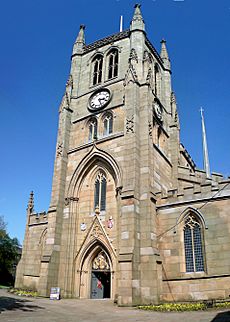
Blackburn Cathedral used to be called St Mary's Parish Church. It became a cathedral in 1926 when the Diocese of Blackburn was created. Blackburn was chosen because it had great public transport, with the cathedral right next to the bus and railway stations. Between the 1930s and 1960s, the cathedral was made much bigger. Six of its bells were made in 1737 and might even come from older bells.
Ewood Park Stadium
Ewood Park is the home stadium of the Blackburn Rovers football team. It opened in April 1882. The stadium was rebuilt in the 1990s and officially reopened in November 1995. It can hold 31,367 fans. The stadium has four main sections: the Darwen End, Riverside Stand, Blackburn End, and the Jack Walker Stand (named after a famous local businessman and club supporter).
Queen Victoria's Statue
Blackburn has a statue of Queen Victoria next to the cathedral. Her daughter, Princess Louise, Duchess of Argyll, unveiled the statue on September 30, 1905. It was made by Sir Bertram McKennal from white Italian marble. The statue is 11 feet (3.4 m) tall and weighs nine tons.
Blackburn Town Hall
Blackburn's original Town Hall was finished in 1856. It cost about £35,000 back then. It had a police station, a large meeting room, and a council chamber. A tall extension, known as the New Town Hall, was built in 1969. The two buildings are connected by a walkway.
Technical School
The Technical School was built in the 1800s with lots of decorations. It's made of red brick and yellow terra cotta. Today, it's part of Blackburn College. The Prince of Wales even placed a time capsule in its wall during a visit! The college celebrated its 125th birthday in 2013.
Cotton Exchange
The Cotton Exchange was built in 1865. It was a place where people traded cotton. In 1881, it was changed to be a performance hall. Later, in 1918, it became a cinema and stayed that way until 2005. Now, it's used for different events like festivals and exhibitions.
Other Cool Places
- Wainwright Bridge opened in 2008. This 12 million[convert: unknown unit] bridge crosses the railway lines and is named after Alfred Wainwright, a famous guidebook author.
- Blackburn Arena opened in 1991. It has an ice rink and is home to the Blackburn Hawks ice hockey team.
- Blackburn railway station has a 24-foot (7.3 m) mural showing eight famous people connected to the town, including Mohandas Gandhi.
- BBC Radio Lancashire has its studios in Darwen Street.
- Thwaites Brewery has been in the town center since 1870.
- King George's Hall is a big arts and entertainment center.
- St Anne's Roman Catholic Church is a beautiful church built in 1926. It was rebuilt in 2004 after a fire.
Parks and Green Spaces
- Corporation Park is north-west of the town center. It opened in 1857. It has a conservatory, which opened in 1900. The park also has the Blackburn War Memorial, honoring those who died in the World Wars.
- Queen's Park opened in June 1887. It originally had bowling greens, tennis courts, a lake, and a paddling pool.
- Witton Country Park is a huge 190-hectare (480-acre) park west of the town. It's bigger than all the town's other parks combined! It has a high school, football pitches, and an athletic track.
- Roe Lee Park in the north of town opened in 1923. It has bowling greens and a children's playground. All four of these parks have won Green Flag awards for being great green spaces.
Libraries
Blackburn Central Library is in the town center. It's one of the most visited libraries in England! It has sections for information, media, local history, and a children's library. There are also smaller libraries in other parts of Blackburn.
Learning in Blackburn
Blackburn has nine state-funded schools and one private school for secondary education. Tauheedul Islam Girls' High School became the first Muslim state school in the North West in 2005. Tauheedul Islam Boys' High School and Queen Elizabeth's Grammar School are also now state-funded.
The town also has special schools for children who need extra support. Over £25 million was invested in education in Blackburn with Darwen in the late 2000s, building new schools and learning centers. Many adults also take part in educational programs.
Blackburn College and St. Mary's College offer further education. While Blackburn doesn't have a university, some higher education courses are available through the East Lancashire Institute of Higher Education.
Local News and Entertainment
Local TV news is provided by BBC North West Tonight and ITV Granada Reports.
You can listen to local radio stations like Central Radio North West and BBC Radio Lancashire. Other stations include Heart North West, Greatest Hits Radio Lancashire, and Capital Manchester and Lancashire.
The local newspapers are the Lancashire Telegraph and Lancashire Post.
Sports in Blackburn
Football Fun
The EFL Championship team Blackburn Rovers plays at Ewood Park. The club started in 1875 and was one of the first teams in The Football League in 1888. Before the Premier League started in 1992, Blackburn Rovers had won the league twice and the FA Cup six times. In 1995, they won the English Premier League! In 2002, they also won the League Cup.
Ice Hockey Action
Blackburn has a large ice rink at the 3,200-seat Blackburn Arena. It's home to the Blackburn Hawks and Lancashire Raptors ice hockey teams. Both teams play in the English National Ice Hockey League.
Cricket Clubs
While the main Lancashire County Cricket Club plays in Manchester, Blackburn has its own town club, the East Lancashire Cricket Club, at Alexandra Meadows. Blackburn Northern Cricket Club also plays its matches at the Ribchester Cricket Ground.
Famous Faces from Blackburn
Artists and Musicians
- Tony Ashton (1946–2001), rock musician
- Michael Billington (1941–2005), actor
- Josephine Cox (1938–2020), fiction writer
- Ross Eccles (born 1937), artist, known for paintings of Blackburn
- Kathleen Ferrier (1912–1953), singer
- Christina Gabbitas (born 1967), author
- Michael Gibson (born 1980), TV presenter
- Barry Gray (1908–1984), composer
- Kathleen Harrison (1892–1995), actress
- Tez Ilyas (born 1983), comedian
- Lee Mack, (born 1968), actor/comedian
- Grace Davies, (born 1997), singer/songwriter
- Ian McShane (born 1942), actor
- Steve Pemberton (born 1967), actor
- Wendi Peters (born 1968), actress
- Diana Vickers (born 1991), singer and actress
- Alfred Wainwright (1907–1991), guidebook author
- Michael Winterbottom (born 1961), film maker
- AJ Odudu (born 1988), television host
Sports Stars
- Gareth Ainsworth (born 1973), footballer and manager
- Iain Balshaw (born 1979), England rugby union player
- Carl Fogarty (born 1965), four-time motorcycle World Superbike champion
- Will Greenwood (born 1972), England rugby union player
- David Dunn (born 1979), footballer for Blackburn Rovers and England
- Adam Wharton (born 2004), footballer for Blackburn Rovers
- Scott Wharton (born 1997), footballer for Blackburn Rovers
Scientists
- Timothy Leighton (born 1963), professor of Ultrasonics
- Noel Slater (1912–1973), mathematician and astronomer
- Eric Fawcett (1927–2000), physicist
Blackburn's Twin Towns
Blackburn is connected with these towns around the world:
- Altena, Germany
- Péronne, Somme, France
- Tarnów, Poland
See also
 In Spanish: Blackburn para niños
In Spanish: Blackburn para niños







